This post contains affiliate links.
This is the story of how these 190 sq. ft. tiny rolling hut cabins came to be in an old RV park in Methow Valley.
When Michal Friedrich bought an old farm-turned-RV-park in Washington State’s Methow Valley, he wanted to restore the flood-plane meadow while leaving it open to guests. He called on Seattle architect Tom Kundig, known for his mechanized homes often reliant on archaic pulleys, cranks and levers, to construct alternative mobile cabins (alternative RV park).1
Please enjoy, learn more, and re-share below. Thanks!
Tiny Rolling Hut Cabins in Washington’s Methow Valley

Photos via Faircompanies/YouTube








Photos via Faircompanies/YouTube
Video: Metal-Clad Tiny Wheeled Homes
Resources
Share this with your friends/family using the e-mail/social re-share buttons below. Thanks!
If you liked this you’ll LOVE our Free Daily Tiny House Newsletter with more! Thank you!
More Like This: Explore our Tiny Houses Section
See The Latest: Go Back Home to See Our Latest Tiny Houses
This post contains affiliate links.
Alex
Latest posts by Alex (see all)
- Escape eBoho eZ Plus Tiny House for $39,975 - April 9, 2024
- Shannon’s Tiny Hilltop Hideaway in Cottontown, Tennessee - April 7, 2024
- Winnebago Revel Community: A Guide to Forums and Groups - March 25, 2024






I’ve stayed in one of these. Pretty run down and poorly constructed/designed. Holes or gaps in the glass that can’t be fixed easily. No ventilation so holes cut in the wall for metal fans. Cool idea and they look great in the pictures but the reality isn’t so cool.
I love the overall design, reminiscent of Frank Lloyd Wright! I’m trying to picture it adapted to a THOW.
I have stayed in these huts. Nice design, but not something you would want to live in. Windows break or separate and there is no easy way to replace them. No ventilation — they had to cut a hole in the back wall and add a fan. These are also getting kind or run down and could use some updating. Works better on the design board than in reality.
These huts/cabins first appeared in articles on the internet in the mid to late 2000s, and I was very impressed with the huts and the location. The pictures in this article surprised me. While these are camping cabins and built with materials that are intended to blend with the location, mowing around the cabins would make such a positive difference. I’m saddened to hear that the reality of the design has not worked as well as probably planned. Perhaps that reality is due to a of lack of upkeep and not Tom Kundig’s design. I don’t intend that comment to be snarky or critical; instead, it is intended in a sincere hope that the cabins remain and are successful. I understand that life gets in the way of plans, and the owners may have had issues arise that have prevented their original plans from being implented.
“implemented,” not implented. Gads.
No running water? No thanks.